10 Things You Should Know About Building Your Own Laneway Suite
Volition was featured on HGTV.ca to share top tips for building a laneway suite – you can check it out here.
In true Volition fashion, the original was WAY over the max character count, so we’ve posted it below. Read on for the FULL version!
Laneway houses are a unique solution to Toronto’s high real estate prices and creative way to add gentle housing density and expand housing options in the city. They are secondary dwellings constructed on residential lots that abut a publicly designated laneway, and offer tremendous flexibility from rentals to work from home spaces to housing loved ones. Volition partnered with Lanescape and Ambient Designs, leading authorities on laneway development, to share the top 10 things you should know about building your own laneway suite.
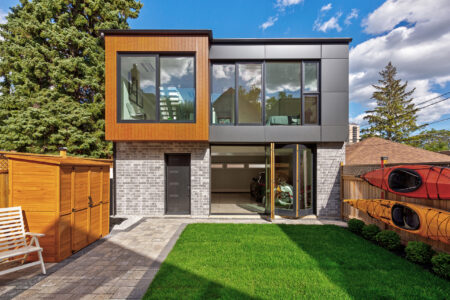
Credit: Lanescape
Why Laneway Suites?
Laneway suites offer incredible flexibility for a wide variety of use cases. Possibilities include multi-generational living for adult children priced out of the hot Toronto market or loved ones to age in place, income properties with or without maintaining the garage for homeowner use, or live/work flex space. They can range from 450 to more than 1,700 square feet above grade, and be a place for both end users and tenants to call home.
The Design and Build Process
It is exciting to build a home completely customized to your needs! Consider the use case, shared use of the backyard (or not), and parking requirements as that will inform the design selection and development budget. Expect the project to take up to a year, with the first half for design and approvals. Services such as gas, electricity, and water are typically supplied from the main house, and can either be sub-metered (hydro) or on a check meter (gas and water). Don’t forget to plan for contingency (typically 10-15% to account for unknowns in servicing, market fluctuations, and flexibility in decision-making), tax, and fun but potentially pricey items such as landscaping, furniture, and decor!
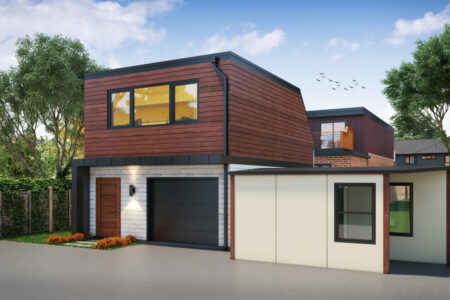
Credit: Ambient Designs
Site Requirements
The “Changing Lanes” initiative approved by the City of Toronto in 2018 allows self-contained residential units to be built as-of-right (without a lengthy and costly public hearing and approval process) if the site meets the zoning bylaws and related requirements. Considerations include abutting a municipally designated laneway and emergency service access. It is important to work with seasoned professionals with laneway suite experience as not all lots with garages are eligible for laneway houses, and it can be a costly mistake to acquire a property without confirming laneway suite eligibility. Lanescape offers free property reviews when you e-mail info@lanescape.ca with a survey or address, and eligibility and an approximate buildable area can be provided without a site visit. Due diligence from multiple sources and additional documentation will be required to determine the final buildable area and options.
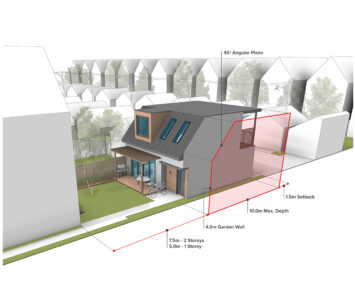
Credit: Lanescape
Use Case: Income Property
Laneway suites are a terrific alternative to basement suites and condos as income properties. Tenants and landlords don’t have to share walls, entrances, or laundry, and private outdoor spaces can be created for tenants to enjoy. Tenants will pay premium rents for a property with no shared walls with their landlord, and landlords enjoy multiple benefits: lower acquisition costs, ability to sub-meter utilities, price appreciation, and low maintenance. Rental units can be over one or two floors, and garage or flex space can be reserved for homeowners on the main floor.
Construction costs range from $300 to $400 per square foot excluding development costs, contingency and taxes, but the rental income produces a higher ROI than a condo. The costs vary widely based on the level of finishes (e.g., rental vs. end-user), and the cost per square foot decreases as the building size increases). A two-story laneway house in Toronto can rent for more than $3,000 per month and can be paired with a multiplex conversion for the main house for investors to enhance returns even further.

Credit: Lanescape
Use Case: Multi-generational Living
Multi-generational living reflects our changing demographics, and laneway houses can accommodate families through different phases of life. This ranges from adult children priced out of the hot real estate market with a win-win by building family equity while paying their share of the mortgage, retirees downsizing and trading spaces with their children for a carefree pied-à-terre while traveling the world, or elderly parents aging in place with thoughtfully-designed main floor living spaces and supportive family mere steps away.
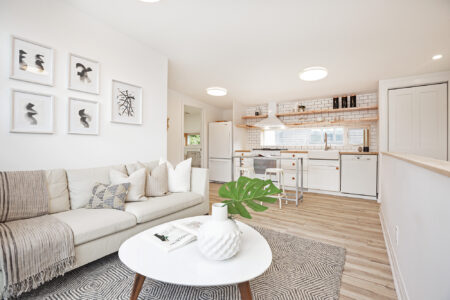
Credit: Lanescape
Use Case: Live/Work Flex Space
We have learned how powerful flex spaces can be: they can serve as offices, studios, gyms, guest suites, or a retreat from the family! These are best considered as an extension to the main house and can include a shared backyard and indoor garage. They can also be used as short or long-term furnished rentals for supplemental rental income when the unit is not in use – win-win!
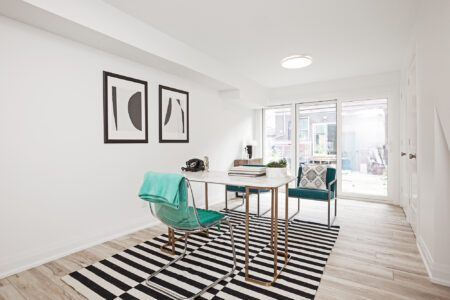
Credit: Lanescape
Parking and Outdoor Spaces
Zoning bylaws do not require parking for laneway suites, but parking can still be incorporated into the design at your own discretion. The only parking requirement is to provide two bicycle parking spaces which can be located inside the structure, within the laneway setback, or at the rear yard.
For outdoor spaces, a 1.5 m setback is required from the lane which can be attractively landscaped, and there are no restrictions on fencing off a portion of the backyard dedicated to the laneway house. Imagine your own private outdoor oasis alongside all the comforts of home, and space to entertain your guests!
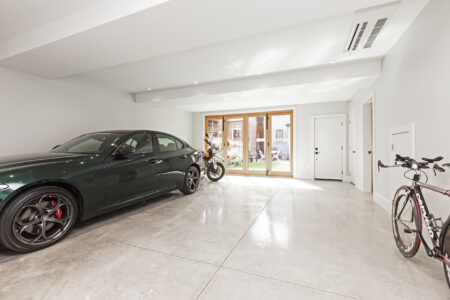
Credit: Lanescape
Design Decisions
The use case will drive decision criteria which include cost, maintenance, and durability. Laneway suite design involves tradeoffs and optimization in a small footprint. Creative solutions include space-efficient tankless hot water heaters and radiant floor heating, and using skylights instead of windows to preserve privacy from the main house and surrounding neighbours. Adding a basement is possible, but often expensive, so the use case should be well defined to ensure it makes financial (or personal) sense.
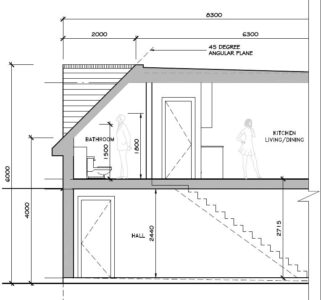
Credit: Ambient Designs
Looking Ahead
Emboldened by the early success of laneway suites, the City of Toronto is exploring alternative forms of housing, and other municipalities such as Hamilton are embracing the mandate.
The city is looking into developing a policy for garden suites, which are detached accessory dwelling units located in the rear yard of a house. They would enable greater housing flexibility for homeowners and families who do not currently have access to laneways with their current properties. There is a current survey underway to gather public input to inform the new policy, and you are invited to complete the online survey and participate in public consultations being held in May 2021.

Credit: City of Toronto
Next Steps: Building Your Dream Team
It can feel daunting to embark on a construction project of this scale. Consider all the professionals you have to engage: real estate agents, mortgage/construction financing experts, architects, engineers, and builders.
Volition Properties is a firm with deep real estate investing and construction experience. We leverage in-house expertise and partner with trusted firms to acquire, design, and build your dream laneway home. At Volition, we manage the entire process for you – not just the professionals mentioned above, but also communication and managing relations with neighbours, tenants, and other stakeholders.
We want to make it an exciting time and a successful experience, and encourage you to take the time to educate yourself on laneway housing in Toronto. Two great options include joining the Toronto Real Estate Mastermind Meetup group to connect with like-minded individuals, and attending free monthly information sessions hosted by Lanescape.
